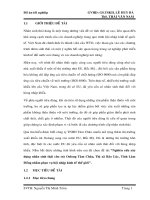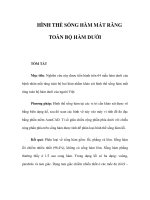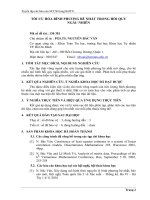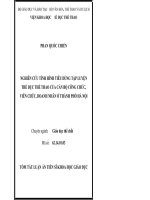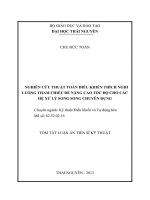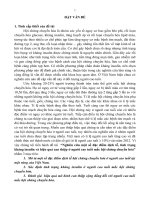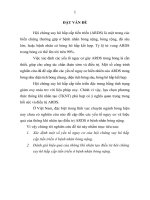Tóm tắt hội nghị châm cứu thế giới Italy 2022
Bạn đang xem bản rút gọn của tài liệu. Xem và tải ngay bản đầy đủ của tài liệu tại đây (12.95 MB, 50 trang )
Welcome to
From Research to Clinical Practice: towards Integrative Medicine
Italian Ministry of Health
CITTÀ
METROPOLITANA
DI BOLOGNA
1
CONTENTS
Welcome messages 3
Organization and committees 7
Detailed Program 14TH October 8
15TH October 10
16TH October 12
Detailed Vets Program 14
Supporters 15
Sponsors 17
Book of Abstracts 18
Science Award 2022 50
2
Hedi Luxenburger WELCOME MESSAGES
President of ICMART
Dear Colleagues and friends,
it is our great honor, that AMAB is hosting this year´s 35th ICMART World
Congress in the beautiful city of Bologna with its rich history.
I want to specially thank the organisers who have taken the challenging task to
organize a big international congress with all the incertainties in those difficult
times of the pandemic and now also the war in Ukraine.
And it was the right decision to meet onsite again, the response of participants
was overwhelming. Everybody is looking forward to continue the tradition of
ICMART congresses with meeting colleagues with similar interests from all over
the world. We are all looking forward to scientific exchange, new knowledge on
practical treatment options and also to meeting our friends and also finding new
ones.
The topic of the congress is very up to date. There is growing evidence on the
positive effects of acupuncture for many different conditions. Medical
Acupuncture should be applied within an integrative medical approach in order
to reach the the highest treatment standard for the patient combining the best
diagnostic and treatment options from both worlds.
I wish everybody a great congress
3
Carlo Maria Giovanardi Dear Collegues,
Congress Chair Welcome to the 35th ICMART World Medical Acupuncture Congress in Bologna,
home of the Alma Mater Studiorum founded in 1088 and considered to be the oldest
university in in the Western world.
Its history is intertwined with that of the great names of science and literature, it is a
keystone and a point of reference for European culture. Among the students and
professors who over the centuries wrote the history of the University of Bologna are
well-renowned anatomists of the XVI and XVII centuries, such as Andrea Vesalio,
Antonio Maria Valsalva, Giovanni Battista Morgagni, Marcello Malpighi and illustrious
people, such as Leon Battista Alberti, Thomas Becket, Nicolò Copernico, Dante
Alighieri, Erasmo of Rotterdam, Albrecht Dürer and Paracelsus.
We are now living in a transition period from the COVID-19 pandemic back to the
normal life we have ‘reconquered’. Not only have these years deeply affected our lives,
but they have also represented a new challenge for modern biomedicine.
The congress theme “From Research to Clinical Practice: towards Integrative
Medicine” aims to be a contribution towards a new approach to the patient: how we
can translate research evidence on acupuncture and related techniques to daily
clinical practice and integrate such growing evidence with Traditional Eastern
Medicine:
In response to patient complexity, and specifically I am referring to chronic patients
where the effectiveness of treatment is reduced by poor adherence and iatrogenic side
effects/complications, acupuncture and related techniques have proved to be
effective, may represent an alternative to conventional therapy or a way towards
integrated treatment.
Being non-pharmacological and cost-effective treatment, acupuncture and related
techniques are sustainable treatment options since they help reduce the use of drugs
and consequently, the presence of pharmaceutical metabolites in the environment.
How to respect the environment is another topic covered by 2022 ICMART to ideally
follow the line successfully traced by the ICMART Congress organized by SAMAG in
Athens in 2021.
Bologna is ready to welcome you: it’s a town rich in tradition and culture where
emotions can be experienced and shared with friends.
In a spirit of co-operation and friendship, I wish I could meet you to get new insights
into latest scientific news, share knowledge, grow professionally, and enjoy three days
in Bologna: in other words, starting over!
4
Umberto Mazzanti We moved from Montpelier to Bologna, and I do not think that one could find a more
Congress Co-Chair beautiful or more free place in all the world. … At once both sweet and bitter, as you
are well aware, it is for me to recall, amidst all these miseries, that happy time, when….
I was a student there.
(Petrarch, XIV century, Letters of Old Age)
Dear Colleagues,
Most of us are no longer students, regretfully I would say, but we keep on studying,
lecturing, researching, publishing …in other words, we strive for knowledge.
That’s what we all have in common and that’s why we have decided to rise to the
challenge and organize the 35th ICMART congress: an in-person event to welcome
you all in Bologna.
No doubt, these are times of miseries, as Petrarch said, but where else can we find
courage and support if not in enriching our lives with the latest scientific news, new
professional relationships and new friends?
And how possibly can we reach this goal? The best way is to meet and talk, listen to
each other’s contribution, ask questions, raise and clear doubts.
That’s what scientists do, that’s what we do, and that’s the lesson we have received
from that branch of Medicine we all have chosen: all things exist as inseparable and
contradictory opposites and are composed of two opposite but mutually
interconnected forces, known as yin and yang.
The pandemic has created a market for doom and gloom, but we know that the seeds
of renaissance are already here. For all of us, who believe in science, that special
seed we need to make grow is research.
Let’s meet in Bologna to widen our horizons and build our future together!
5
Roberta Pozzi Dear Colleagues,
SIAV President
As you know every year a different nation has the honour to host the ICMART
Congress.
For the year 2022, the choice fell on Italy and the A.M.A.B. is the Association in charge
of the organization.
The SIAV is a Veterinary Association that organizes an annual international Congress
on acupuncture and TCM.
The SIAV and A.M.A.B. have chosen the path of spreading the knowledge of TCM,
acupuncture, and related techniques in Italy and abroad.
They are well known and renowned schools which have played a leading role in our
beautiful country over the years.
That's why, the SIAV and A.M.A.B. have decided to join forces and hold the 35th
ICMART Congress and the 23rd SIAV International Congress together, with common
sessions dedicated to TCM and others more specifically focused on human or
veterinary acupuncture.
Our daily practice may be different, but we all have a great source of inspiration in
common: the ancient and always true wisdom of TCM.
Being together in this adventure will surely allow us to share knowledge and points of
view thus enhancing both the Vets' and MDs' practice of acupuncture.
Looking forward to meeting you all in Bologna!
Eliana Amorosi
SIAV Secretary
6
ORGANISATION AND COMMETTEES
Congress Presidents ICMART Board ICMART Congress
Committee
Carlo Maria Giovanardi, Chair, AMAB Hedi Luxenburger, President
Umberto Mazzanti, Co-Chair, AMAB Konstantina Theodoratou, General Petja Piehler, Austria
Hedi Luxenburger, ICMART Secretary Chin Chan, Australia
Chin Chan, Vice-President Tomas Dawid, Uruguay
Tomas Dawid, Vice-President Hedi Luxenburger, Germany
Patrick Sautreuil, Vice-President Chun Lee Oei-Tan, Netherlands
Petja Piehler, Treasurer Konstantina Theodoratou, Greece
Thomas Burgoon, Past Director Marica Yamamura, Brazil
Silvia Elenkova, Past Director
Dominik Irnich, Past Director
Chun-Lee Oei-Tan, Past Director
Paola Poli, Past Director
Siddhartha Popat, Past Director
Karin Stockert, Past Director
Marcia Yamamura, Past Director
Franỗois Beyens, Honorary President
2022 ICMART Congress ICMART Scientific ICMART Science Award
Scientific Committee Committee Jury
Maria Letizia Barbanera Dominik Irnich, Germany Chin Chan
Elisabetta Casaletti Tomas Dawid, Uruguay Tomas Dawid
Giuseppina Maria Grazia Farella Chun-Lee Oie-Tan, Netherlands Dominik Irnich
Carlo Maria Giovanardi Paola Poli, Italy Francisco Lozano
Annunzio Matrà Konstantina Theodoratou, Greece Chun Lee Oei-Tan
Mauro Mattarelli Marcia Yamamura, Brazil Konstantina Theodoratou
Umberto Mazzanti
Alessandra Poini
Sotirios Sarafianos
Giuseppe Tallarida
Roberto Tedeschi
Eliana Amorosi
Giuseppe Brambilla
Debora Groppetti
Gudrun Mayr Boninsegna
Roberta Pozzi
Narda G. Robinson
Thomas Burgoon
Francisco Lozano
7
DETAILED PROGRAM
14TH OCTOBER
8
9
15TH OCTOBER
10
11
16th OCTOBER
12
13
DETAILED VETS PROGRAM
14
HOSTED BY
WITH THE INSTITUTIONAL SUPPORT OF
Italian Ministry of Health
AND
15
WITH THE SUPPORT OF
16
SPONSORED BY
www.laodan.it www.suwenherbs.com
17
BOOK OF ABSTRACTS
Acupuncture and Moxibustion for Cancer-Related Fatigue: An Overview of
Systematic Reviews and Meta-Analysis
Tae-Young Choi, Lin Ang, Ji Hee Jun, Terje Alraek, Hye Won Lee and Myeong Soo Lee
Alraek Terje
National Research Center in Complementary and Alternative Medicine, NAFKAM.
Department of Community Medicine Faculty of Health Science UiT, The Arctic University of Norway, Tromsø, Norway.
Scool of Health Sciences, Kristiania University College, Oslo, Norway.
Although acupuncture (AT) is used in the treatment of CRF, the evidence from different systematic reviews (SRs) of AT has not
yet been comprehensively evaluated. Moxibustion, which is a treatment method that is well established within Traditional East
Asian Medicine, applies the heat of burning herbs towards or onto special points on the skin. Commonly, the herb Artemisia
vulgaris, is used. It has been used for palliative cancer care, as well as for CRF. The aim of this overview was to evaluate the
efficacy of AT and moxibustion in the management of CRF. Methods Eleven databases were searched through for studies that
were published from their dates of inception to February 2022. The study selection, the data extraction, and the assessment
were performed independently by two researchers. The methodological and report quality were assessed by using the
Assessment of Multiple Systematic Reviews-2 (AMSTAR-2) tool. The evidence quality was evaluated by using the Grading of
Recommendations Assessment, Development and Evaluation (GRADE) system. Results Fifteen SRs on AT (n = 10) and
moxibustion (n = 5) treatments for CRF were included, and they include 169 randomized controlled trials and 14,392
participants. All the SRs that were evaluated by the AMASTAR-2 had more than one deficiency, and so all the SRs were rated
as either low or critically low. For the GRADE, 18 outcomes were rated as very-low-quality evidence, 13 as low-quality evidence,
3 as moderate-quality evidence, and 0 as high-quality evidence. Most of the SRs reached the potential benefits of AT for CRF.
No serious adverse effects were identified. Conclusions In conclusion, the evidence suggests that, despite the advantages of AT
in terms of the improvement in and the safety of the treatment of CRF, the methodological quality of most of these studies is
low, which limits our ability to draw definitive meanings. Further research of high quality is needed to confirm these findings.
Cosmetic acupuncture: treatment with massage and needling for facial aging
(Workshop)
Barbanera Maria Letizia
MD, Professor at AMAB - Italian-Chinese School of Acupuncture
Cosmetic acupuncture is a natural way to fight the signs of aging, it allows to correct little cosmetic defects with a non-invasive
method, respecting the natural beauty of the body. There are a lot of techniques typically used in cosmetic acupuncture; all with
the purpose of enhancing the beauty in a gentle way without the artificial effects of aesthetic surgery. Furthermore, Chinese
medicine observes the body with an holistic point of view, so it aims to treat the root of a disease and not only the clinical
manifestation. This, in the cosmetic field, enables a physical aspect of health and wellness, giving the appearance of body
rejuvenation. Another benefit of cosmetic acupuncture is the safety, while cosmetic surgery, in addition to the risks of the
techniques itself, can give errors visible to the naked eye, if applied with no respect of natural shapes and proportions of the face.
In this workshop we will focus on two simple techniques to treat facial aging and wrinkles, using the Guasha instrument and the
needles. Guasha is a tool used in Chinese medicine to scratch and massage the skin; together with the needles it gives the input
to the skin to stimulate the blood and lymphatic flow, enhancing the oxygen exchanges and the elimination of the toxins, and
stimulates the fibroblasts to increase the production of collagen and elastin.
18
Nogier's error? The scientific method and the establisment of auricular maps
Bazzoni Giancarlo
CERNATEC - Center for Researches in Auricular Neuromodulation and Complementary Therapy - Sassari University
IANMA International Auricular Neuromodulation Academy Italy - Greece – Spain
SIRAA Italian Society of Reflexotherapy, Acupuncture and Auricular Therapy - Torino
One of the central and unavoidable problems that modern medicine has to face is to define the epistemological status of those
medical disciplines that aspire to belong to it. Among these are the so-called CAM, which include Auricular Acupuncture, also
called Auriculotherapy. The first auricular map was presented in 1957 and included 18 auricular areas/points. Since then, the
number of areas/points has grown exponentially. The two most recent auricular maps that evolved within the French - German
model, published recently by F. Bahr (300 areas/points) and D. Alimi, 180 areas/points.
In this paper we have examined the different methods used by P. Nogier and his collaborators to construct the auricular French
map. The time span examined is from 1951 to 1989, since the map has remained substantially unchanged. An approach was
used that integrates the historical-epistemological method with the anatomical-physiological and clinical knowledge that is
currently part of all therapeutic techniques applied to the external ear. DISCUSSION The path that led to the construction of the
current auricular maps can be divided into different periods. 1st Period, 1951 - 1956, which led to the birth of the first auricular
map. Its keywords are serendipity, abductive method, spontaneous pain, pressure pain test. 2nd Period, 1957 - 1968. Provoked
pain, pressure pain test and (from 1963) skin electrical resistance test. 3rd Period, 1968 - 1989. The RAC (Cardiac Auricular
Reflex) also called VAS, was used in combination with the use of ampoules containing a homoeopathic preparation of a tissue
whose auricular representation was to be identified.
The aim was to identify auricular representations unrelated to pain. This method has been employed in the: 1970 thoracic and
abdominal viscera. 1975 endocrine functions, CNS and SNP, psychic points. 1989 other localizations.
Nogier was a brilliant and rigorous researcher, but of course his studies and research methods were based on the scientific
knowledge of his time. The problem arises from the fact that these maps, the result of a serious methodological error, are still
used in clinical practice today. The error is therefore not to be attributed to the doctor from Lyon, but rather to his pupils and to all
of us who have accepted in a fideistic and uncritical manner a teaching that is still valid and useful in clinical practice, but in some
outdated aspects by the progress of medical science.
Sham acupuncture, problems and implications: an evidence-based analysis
Birch Stephen
PHD, Associate professor Kristiania University College, School of Health Sciences, Oslo
Sham acupuncture has been used in clinical trials in the West since the early 1970s. Many techniques have been used, some
becoming more common in recent years. What assumptions underlie the selection of these sham techniques and are they correct?
Sham acupuncture has been applied in several different trial designs, each answering different questions. Have researchers been
aware of this and if not, what are the findings and implications of accidentally using the wrong design? Sham acupuncture is used
in order to control for placebo effects. What steps are needed that allow an acupuncture trial to be a placebo-controlled trial? In
addition to demonstrating successful blinding of treatments, the sham treatment must be either demonstrated to be biologically
inert or have reliable methods for assessing and controlling for anybiological effects. What plausible biological effects can be
associated with sham acupuncture techniques? Have any studies successfully controlled for these or are able to control for these?
If there is a problem with regards trials applying these steps correctly, what does that mean for any conclusions about placebo
effects in acupunctureand the effect size of acupuncture treatments?
The author has been working on acupuncture trial design, sham acupuncture, and placebo in acupuncture for 30 years. In recent
years he has collaborated with Terje Alraek, Myeong Soo Lee and Tae-Hun Kim, publishing a series of papers on sham
acupuncture and the profound problems surrounding it. This lecture will present evidence to support the notion that sham
acupuncture should no longer be used as a comparison treatment in clinical trials of acupuncture and that interpretation of results
of trials needs to be re-examined.
19
The Role of Acupuncture and Moxibustion in the Modern Treatment of Asthma
Burgoon Thomas
Past President, American Academy of Medical Acupuncture
Board Member of ICMART
Acupuncture is an effective and valuable therapy in the modern management of asthma. This talk reviews the approach and some
techniques of an internal medicine specialist who has applied acupuncture and moxibustion in the therapy of asthma for more
than twenty years. Also, the modern bench science supporting acupuncture’s role in asthma management is reviewed.
Acupuncture performed before and after embryo transfer: 2002-2022, twenty years of
IVF-ET treatments
Casaletti Elisabetta
MD, Professor at AMAB - Italian-Chinese School of Acupuncture
Infertility is on the rise, especially because many couple choose to have children later in life. One in four in developing countries
is affected by infertility. In recent years, acupuncture has become increasingly popular in assisted reproduction and IVF to increase
the number of chances of conception. Patients who wish to maximize their chances of conception often purchase additional
treatments to augment their IVF cycle. In IVF clinics and private clinics, acupuncture for ET is the primary treatment required and
performed. It has been 20 years since Wolfgang E. Paulus was published his small prospective randomized study using a
standardized acupuncture protocol, full of hope. After 20 years, we discover numerous articles on it, but the findings are sometimes
unreliable due to severe heterogeneity and methodological quality defects, also if the quality of clinical studies upgrades. In order
to develop new clinical strategies for infertile couples, we will go through the most relevant bibliography and suggest reflections
on acupoints and timing.
The Effectiveness of Acupuncture on Long COVID-19 Fatigue
Cayir Yasemin
Ataturk University Faculty of Medicine Ataturk University, Research and Practice Center for Acupuncture and Complementary
Therapy Modalities
The aim of this study is to investigate the effectiveness of acupuncture on Long COVID fatigue. Material and Method: This
randomized-controlled trial was carried out with 60 Long-COVID patients with fatigue in December 2021 and March 2022.
Participants were randomly assigned to the Acupuncture Group (AG;) and Control Group (CG; n=30) and were followed up for 4
weeks. While AG received a total of 12 sessions of acupuncture 3 times a week for 4 weeks; no intervention was made in CG.
The primary outcome measure was the mean change on Fatigue Severity Scale (FSS) at the endpoint. The secondary outcome
measure was the mean change of Short Form-36 Quality of Life Scale (SF-36) scores from baseline to endpoints. The data were
analyzed with SPSS and statistical significance was accepted as p0.05). While the mean score of the FSS before the study was
6.1± 0.8 in the AG; it was 5.3±1.0 in CG (p=0.002). At the end of the study, while the FSS score decreased to an average of
3.0±1.4 in AG; it decreased to 4.4±1.3 in CG (p=0.000). While there was a 50.8% decrease in the severity of fatigue compared to
the baseline in AG; a decrease of 16.9% was observed in the CG. The Physical Function, Physical Role Difficulty, Energy, Mental
Health, and Pain sub-dimension scores of SF-36 were significantly lower in AG compared to CG at the beginning.
20

